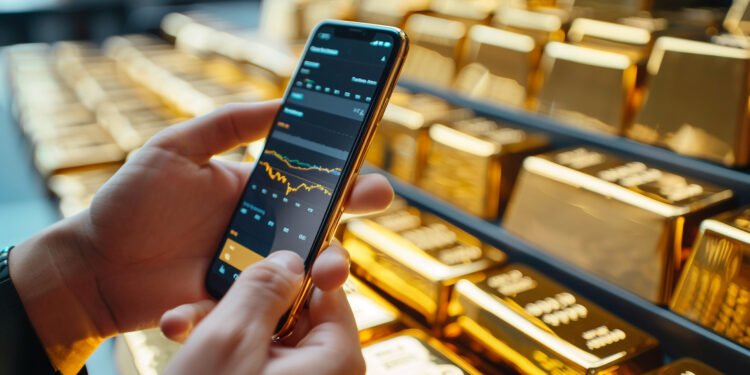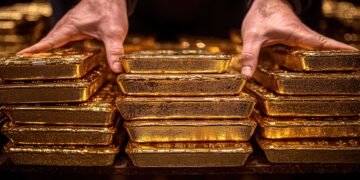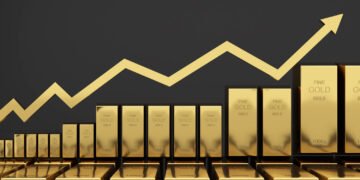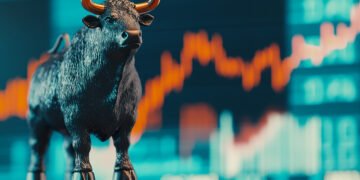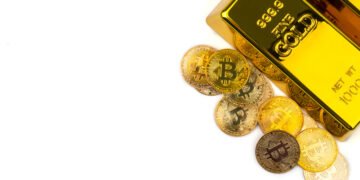Gold has reached unprecedented territory, with spot prices climbing above the inflation-adjusted record high established during the tumultuous economic period of 1980. This milestone reflects not only immediate market dynamics but also fundamental shifts in global economic conditions, monetary policy expectations, and investor behavior that distinguish the current precious metals rally from previous cycles.
Breaking Historical Price Barriers
Spot gold reached $3,674.27 per ounce during recent trading sessions, representing a 5 percent increase for the month and an impressive 40 percent gain year-to-date. This price level surpasses the inflation-adjusted equivalent of the previous record high of $850 per ounce established on January 21, 1980, which equals approximately $3,590 when adjusted for inflation using current consumer price index calculations.
The significance of breaking this inflation-adjusted barrier cannot be understated, as it represents the first time in over four decades that gold has achieved genuine price discovery beyond its previous peak performance. The 1980 price spike occurred during a period of severe economic stagflation, geopolitical tensions including the Iran hostage crisis, and unprecedented monetary policy challenges that created extreme safe-haven demand for precious metals.
The current price environment reflects different but equally compelling fundamental drivers that have sustained gold’s appreciation over an extended period rather than creating the sharp but brief price spike characteristic of the 1980 experience. This sustained appreciation suggests broader structural changes in global financial markets and investor behavior rather than purely speculative or crisis-driven demand.
Economic Data Signaling Slowdown
Recent U.S. economic indicators have painted a picture of cooling growth that has contributed to gold’s safe-haven appeal. Initial jobless claims rose by 27,000 to reach 263,000 in the week ended September 6, marking a three-year high that signals potential weakness in the labor market. This increase in unemployment claims suggests that employers may be reducing their workforce in response to economic uncertainty or declining demand for goods and services.
Core consumer prices rose 0.3 percent in August from July, indicating persistent inflationary pressures that continue to erode purchasing power and complicate Federal Reserve policy decisions. This inflation rate, while not at the extreme levels experienced during the 1970s and early 1980s, remains above the Federal Reserve’s 2 percent target and contributes to concerns about the central bank’s ability to maintain price stability.
Nonfarm payrolls increased by only 22,000 last month, representing a dramatic slowdown in job creation that suggests employers are becoming increasingly cautious about expansion plans. This modest job growth figure falls well below economists’ expectations and indicates that the labor market may be losing the momentum that characterized the post-pandemic recovery period.
The unemployment rate rose to 4.3 percent, marking a notable increase from previous months and suggesting that labor market conditions are deteriorating more broadly. This unemployment rate, while still historically moderate, represents a concerning upward trend that could accelerate if economic conditions continue weakening.
Perhaps most significantly, the Bureau of Labor Statistics revised down nonfarm payroll figures for the year ended March 31 by 911,000 jobs, indicating that previous economic strength may have been overstated. This substantial downward revision suggests that the U.S. economy has been weaker than initially reported, casting doubt on the sustainability of current growth trajectories and supporting the case for more accommodative monetary policy.
Stagflation Concerns and Federal Reserve Policy
The combination of persistent inflation and weakening economic growth has revived concerns about stagflation, the challenging economic condition characterized by simultaneous inflation and economic stagnation that plagued the U.S. economy during the 1970s and early 1980s. These economic indicators have contributed to trader expectations of imminent Federal Reserve policy changes.
According to the Chicago Mercantile Exchange’s FedWatch tool, traders are now fully pricing in a 25-basis-point interest rate cut by the Federal Reserve at its next meeting. This expectation reflects market participants’ belief that economic weakness will compel the central bank to reduce borrowing costs despite ongoing inflation concerns.
The prospect of lower interest rates typically supports gold prices because it reduces the opportunity cost of holding non-yielding assets like precious metals. When interest rates decline, the relative attractiveness of gold increases compared to interest-bearing alternatives such as bonds and bank deposits.
Historical precedent suggests that Federal Reserve rate-cutting cycles often coincide with strong gold performance, as investors seek assets that can preserve value during periods of monetary accommodation and potential currency devaluation. The anticipation of such a cycle has contributed to increased institutional and retail demand for gold as a portfolio hedge.
Broader Policy and Structural Factors
Beyond immediate economic indicators, several structural factors have contributed to gold’s sustained strength. U.S. policy decisions have contributed to dollar weakness, reducing the relative cost of gold for international buyers and decreasing the appeal of dollar-denominated assets including U.S. Treasury securities.
Central banks worldwide continue purchasing gold reserves at elevated levels, providing fundamental demand support that differs from previous gold rallies driven primarily by speculative or retail investment activity. This institutional demand creates a more stable foundation for gold prices and suggests that current levels may be more sustainable than previous speculative peaks.
The development of exchange-traded funds and other accessible investment products has democratized gold investing, allowing institutional and retail investors to gain precious metals exposure without the logistical challenges associated with physical gold ownership and storage. This improved accessibility has broadened the investor base and increased the potential for sustained demand during periods of economic uncertainty.
Expert Analysis and Historical Context
Carmen Reinhart, former chief economist at the World Bank, notes that gold was regarded as an effective inflation hedge during the 1970s and 1980s and is being viewed similarly in the current environment. This historical parallel is significant because it suggests that current gold demand reflects rational portfolio allocation decisions rather than purely speculative activity.
Greg Sharenow, a fund manager at Pacific Investment Management Company (PIMCO), emphasizes that gold serves not only as an inflation hedge but also benefits from broader readjustments in global asset allocations. He attributes the surging price to a combination of broad investor participation and policy uncertainties that make traditional assets less attractive.
The current gold rally differs significantly from the 1980 price spike in terms of volatility characteristics. Analysts note that the present rally has been much less volatile, partly due to greater market liquidity and the availability of products like ETFs that make gold more accessible to diverse investor populations. This reduced volatility suggests a more mature and stable market structure that can accommodate larger investment flows without experiencing extreme price swings.
Institutional Demand Indicators
The total value of gold reserves stored in London vaults exceeded $1 trillion for the first time last month, providing concrete evidence of substantial institutional demand. London serves as one of the world’s primary gold trading and storage centers, making vault holdings a reliable indicator of professional investment activity.
This milestone reflects not only higher gold prices but also increased physical accumulation by institutional investors who prefer allocated storage arrangements over paper gold instruments. The preference for physical gold storage suggests that institutional investors view current economic conditions as potentially requiring long-term precious metals exposure.
The institutional character of current gold demand differs markedly from previous rallies that were driven primarily by retail investor enthusiasm or speculative trading activity. Professional investors typically conduct more thorough due diligence and maintain longer investment horizons, suggesting that current demand may be more sustainable than previous cycles.
Geopolitical and Political Factors
Political developments have added another dimension to gold’s appeal as a safe-haven asset. President Trump’s public criticism of Federal Reserve policies and personnel has raised concerns about central bank independence, a factor that analysts identify as supporting gold demand.
Attacks on Federal Reserve independence represent a significant departure from traditional norms that have maintained separation between political leadership and monetary policy decisions. Such political pressure creates uncertainty about future monetary policy effectiveness and credibility, making alternative stores of value more attractive to investors concerned about currency stability.
The intersection of political pressure and monetary policy represents a return to conditions that historically have supported gold demand, as investors seek assets that maintain value independent of political influence or policy changes.
Price Projections and Future Outlook
Goldman Sachs has issued notably bullish projections for gold prices, forecasting potential appreciation to nearly $5,000 per ounce under certain scenarios. The investment bank’s base case scenario projects gold reaching $4,000 by the middle of next year, with a tail-risk scenario of $4,500 per ounce.
Goldman’s most aggressive scenario suggests gold could surge to almost $5,000 per ounce if President Trump’s criticism of the Federal Reserve succeeds in undermining central bank independence and investors reallocate just 1 percent of privately held U.S. Treasury securities into gold. This projection illustrates the potential magnitude of price movements that could result from relatively modest shifts in institutional asset allocation.
These forecasts reflect the bank’s analysis of multiple factors including monetary policy expectations, geopolitical risks, currency dynamics, and institutional investment flows. However, such projections should be viewed as scenario-dependent estimates rather than definitive predictions, given the numerous variables that influence precious metals markets.
Market Structure and Trading Dynamics
Independent metals trader Tai Wong observes that while short-term buyers appear to be tiring, the overall outlook for gold remains constructive with limited potential for significant pullbacks. This assessment reflects analysis of current market positioning, technical indicators, and fundamental supply and demand dynamics.
The current market structure differs from previous gold rallies in several important respects, including greater institutional participation, improved market liquidity, enhanced accessibility through various investment vehicles, and more sophisticated risk management tools. These structural improvements may contribute to more stable price appreciation compared to the extreme volatility that characterized previous precious metals cycles.
The sustainability of current gold prices will depend on the interaction of multiple factors including Federal Reserve policy decisions, economic growth trajectories, inflation trends, geopolitical developments, and currency market dynamics. While current fundamentals appear supportive of continued strength, investors should remain aware of the inherent volatility associated with commodity investments and the potential for significant price corrections during changing market conditions.
Acknowledgment: This article was written with the help of AI, which also assisted in research, drafting, editing, and formatting this current version.

